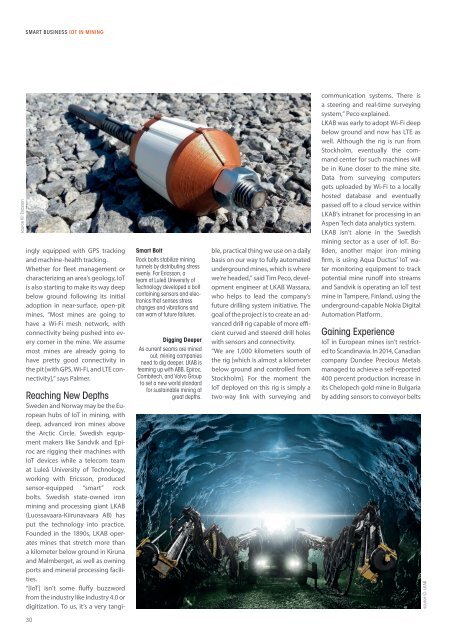Smart Industry 1/2020
Smart Industry 1/2020 - The IoT Business Magazine - powered by Avnet Silica
Smart Industry 1/2020 - The IoT Business Magazine - powered by Avnet Silica
- No tags were found...
You also want an ePaper? Increase the reach of your titles
YUMPU automatically turns print PDFs into web optimized ePapers that Google loves.
<strong>Smart</strong> Business IoT in Mining<br />
source ©: Ericsson<br />
ingly equipped with GPS tracking<br />
and machine-health tracking.<br />
Whether for fleet management or<br />
characterizing an area’s geology, IoT<br />
is also starting to make its way deep<br />
below ground following its initial<br />
adoption in near-surface, open-pit<br />
mines. “Most mines are going to<br />
have a Wi-Fi mesh network, with<br />
connectivity being pushed into every<br />
corner in the mine. We assume<br />
most mines are already going to<br />
have pretty good connectivity in<br />
the pit [with GPS, Wi-Fi, and LTE connectivity],”<br />
says Palmer.<br />
<strong>Smart</strong> Bolt<br />
Rock bolts stabilize mining<br />
tunnels by distributing stress<br />
evenly. For Ericsson, a<br />
team at Luleå University of<br />
Technology developed a bolt<br />
containing sensors and electronics<br />
that senses stress<br />
changes and vibrations and<br />
can warn of future failures.<br />
Digging Deeper<br />
As current seams are mined<br />
out, mining companies<br />
need to dig deeper. LKAB is<br />
teaming up with ABB, Epiroc,<br />
Combitech, and Volvo Group<br />
to set a new world standard<br />
for sustainable mining at<br />
great depths.<br />
Reaching New Depths<br />
Sweden and Norway may be the European<br />
hubs of IoT in mining, with<br />
deep, advanced iron mines above<br />
the Arctic Circle. Swedish equipment<br />
makers like Sandvik and Epiroc<br />
are rigging their machines with<br />
IoT devices while a telecom team<br />
at Luleå University of Technology,<br />
working with Ericsson, produced<br />
sensor-equipped “smart” rock<br />
bolts. Swedish state-owned iron<br />
mining and processing giant LKAB<br />
(Luossavaara-Kiirunavaara AB) has<br />
put the technology into practice.<br />
Founded in the 1890s, LKAB operates<br />
mines that stretch more than<br />
a kilometer below ground in Kiruna<br />
and Malmberget, as well as owning<br />
ports and mineral processing facilities.<br />
“[IoT] isn’t some fluffy buzzword<br />
from the industry like <strong>Industry</strong> 4.0 or<br />
digitization. To us, it’s a very tangible,<br />
practical thing we use on a daily<br />
basis on our way to fully automated<br />
underground mines, which is where<br />
we’re headed,” said Tim Peco, development<br />
engineer at LKAB Wassara,<br />
who helps to lead the company’s<br />
future drilling system initiative. The<br />
goal of the project is to create an advanced<br />
drill rig capable of more efficient<br />
curved and steered drill holes<br />
with sensors and connectivity.<br />
“We are 1,000 kilometers south of<br />
the rig [which is almost a kilometer<br />
below ground and controlled from<br />
Stockholm]. For the moment the<br />
IoT deployed on this rig is simply a<br />
two-way link with surveying and<br />
communication systems. There is<br />
a steering and real-time surveying<br />
system,” Peco explained.<br />
LKAB was early to adopt Wi-Fi deep<br />
below ground and now has LTE as<br />
well. Although the rig is run from<br />
Stockholm, eventually the command<br />
center for such machines will<br />
be in Kune closer to the mine site.<br />
Data from surveying computers<br />
gets uploaded by Wi-Fi to a locally<br />
hosted database and eventually<br />
passed off to a cloud service within<br />
LKAB’s intranet for processing in an<br />
Aspen Tech data analytics system.<br />
LKAB isn’t alone in the Swedish<br />
mining sector as a user of IoT. Boliden,<br />
another major iron mining<br />
firm, is using Aqua Ductus’ IoT water<br />
monitoring equipment to track<br />
potential mine runoff into streams<br />
and Sandvik is operating an IoT test<br />
mine in Tampere, Finland, using the<br />
underground-capable Nokia Digital<br />
Automation Platform.<br />
Gaining Experience<br />
IoT in European mines isn’t restricted<br />
to Scandinavia. In 2014, Canadian<br />
company Dundee Precious Metals<br />
managed to achieve a self-reported<br />
400 percent production increase in<br />
its Chelopech gold mine in Bulgaria<br />
by adding sensors to conveyor belts<br />
source ©: LKAB<br />
30
















